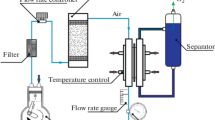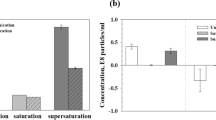Abstract
Micro/nano-bubbles are practical nanomaterials designed to increase the gas content in liquids. We attempted to use oxygen micro/nano-bubble dispersions as an oxygen-rich liquid as a means for total liquid ventilation. To determine the oxygen content in the bubble dispersion, a new method based on a spectrophotometric change between oxy- and deoxy-hemoglobin was established. The oxygen micro/nano-bubble dispersion was supplied to an experimental total ventilation liquid in anesthetic rats. Though the amount of dissolving oxygen was as low as 6 mg/L in physiological saline, the oxygen content in the oxygen micro/nano-bubble dispersion was increased to 45 mg/L. The positive correlation between the oxygen content and the life-saving time under liquid ventilation clearly indicates that the life-saving time is prolonged by increasing the oxygen content in the oxygen micro/nano-bubble dispersion. This is the first report indicating that the oxygen micro/nano-bubbles containing a sufficient amount of oxygen are useful in producing oxygen-rich liquid for the process of liquid ventilation.




Similar content being viewed by others
References
Clark LC Jr, Gollan F. Survival of mammals breathing organic liquids equilibrated with oxygen at atmospheric pressure. Science. 1966;152:1755–6.
Funhrman BP, Paczan PR, DeFrancisis M. Perfluorocarbon-associated gas exchange. Crit Care Med. 1991;19:712–22.
Moskowitz GD. A mechanical respirator for control of liquid breathing. Fed Proc. 1970;29:1751–2.
Tawfic QA, Kausalya R. Liquid ventilation. Oman Med J. 2011;26:4–9.
Kacmarek RM, Wiedemann HP, Lavin PT, Wedel MK, Tütüncü AS, Slutsky AS. Partial liquid ventilation in adult patients with acute respiratory distress syndrome. Am J Respir Crit Care Med. 2006;173:882–9.
Hirschl RB, Croce M, Gore D, Wiedemann H, Davis K, Zwischenberger J, Bartlett RH. Prospective, randomized, controlled pilot study of partial liquid ventilation in adult acute respiratory distress syndrome. Am J Respir Crit Care Med. 2002;165:781–7.
Leanch CL, Greenspan JS, Rubenstein SD, Shaffer TH, Wolfson MR, Jackson JC, Delemos R, Fuhrman BP. Partial liquid ventilation with perflubron in premature infants with severe respiratory distress syndrome. N Engl J Med. 1996;335:761–7.
Tamura M, Nakamura T. Principle and clinical application of liquid ventilation. Shinshu Med J. 2001;49:239–48.
Cox CA, Fox WW, Weiss CM, Wolfson MR, Shaffer TH. Liquid ventilation: gas exchange, perfluorochemical uptake, and biodistribution in an acute lung injury. Pediatr Crit Care Med. 2002;3:288–96.
Jiang L, Wang Q, Liu Y, Du M, Shen X, Guo X, Wu S. Total liquid ventilation reduces lung injury in piglets after cardioplumonary bypass. Ann Thorac Surg. 2006;82:124–30.
Tsagogiorgas C, Alb M, Herrmann P, Quintel M, Meinhardt JP. Cardiopulmonary function and oxygen delivery during total liquid ventilation. Pediaric Pulmonol. 2011;46:964–75.
Lowe KC. Perfluorinated blood substitutes and artificial oxygen carriers. Blood Rev. 1999;13:171–84.
Takahashi M, Chiba K, Li P. Free-radical generation from collapsing microbubbles in the absence of a dynamic stimulus. J Phys Chem B. 2007;111:1343–7.
Bisazza A, Giustetto P, Rolfo A, Caniggia I, Balbis S, Guiot C, Cavalli R. Microbubble-mediated oxygen delivery to hypoxic tissues as a new therapeutic device. In: Conference Proceedings IEEE Engineering Med Biol Society 2008; 2067–2070.
Cavalli R, Bisazza A, Giustetto P, Civra A, Lembo D, Trotta G, Guiot C, Trotta M. Preparation and characterization of dextran nanobubbles for oxygen delivery. Int J Pharm. 2009;381:160–5.
Matsuki N, Ichiba S, Ishikawa T, Nagano O, Takeda M, Ujike Y, Yamaguchi T. Blood oxygenation using micro bubble suspensions. Eur Biophys J. 2012;41:571–8.
Matsuda K, Sawada S, Bartlett RH, Hirschl RB. Effect of ventilatory variables on gas exchange and hemodynamics during total liquid ventilation in a rat model. Crit Care Med. 2003;31:2034–40.
Swanson EJ, Mohan V, Kheir J, Borden MA. Phospholipid-stabilized microbubble foam for injectable oxygen delivery. Langmuir. 2010;26:15726–9.
Ebina K, Shi K, Hashimoto J. Oxygen and Air Nanobubble water solution promote the growth of plants, fishes, and mice. PLoS One. 2013;8:1–7.
Acknowledgments
We thank IDEC CORPORATION for renting Generator C (Ultrafine GALF), Dr. Masayuki Ohmori (Chuo University, Institute of Science and Engineering) for providing Generator B (A-01) and also advice on the operations of generating micro/nano-bubbles and Ms. Nastuko Kuroki and Dr. Shuji Owada (Waseda University, Department of Resources and Environmental Engineering) for measuring a laser diffraction particle size analyzer (SALD-3100).
Conflict of interest
The authors declare that they have no conflict of interest.
Author information
Authors and Affiliations
Corresponding authors
Electronic supplementary material
Below is the link to the electronic supplementary material.
Rights and permissions
About this article
Cite this article
Kakiuchi, K., Matsuda, K., Harii, N. et al. Establishment of a total liquid ventilation system using saline-based oxygen micro/nano-bubble dispersions in rats. J Artif Organs 18, 220–227 (2015). https://doi.org/10.1007/s10047-015-0835-z
Received:
Accepted:
Published:
Issue Date:
DOI: https://doi.org/10.1007/s10047-015-0835-z




